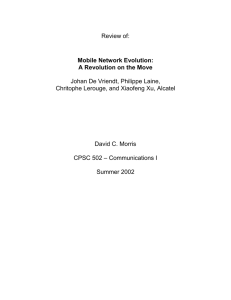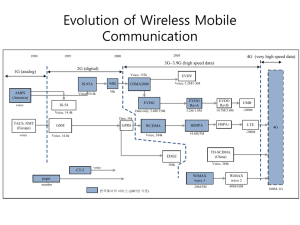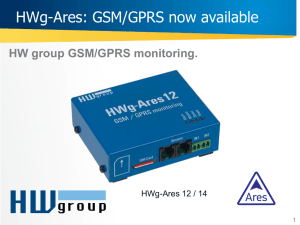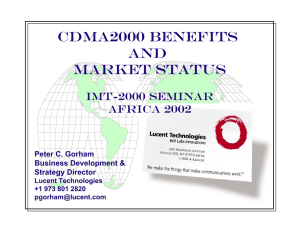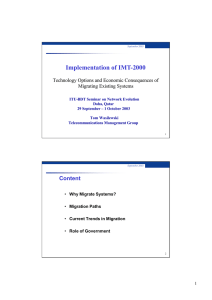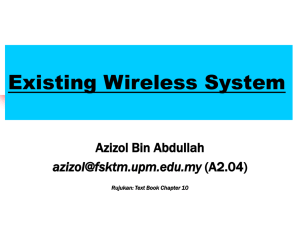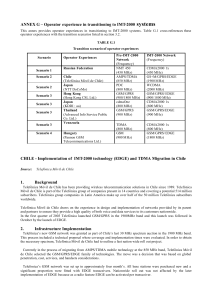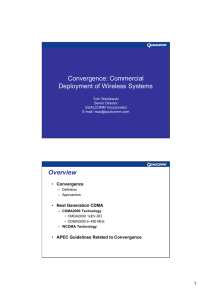chapter2_wireless
advertisement
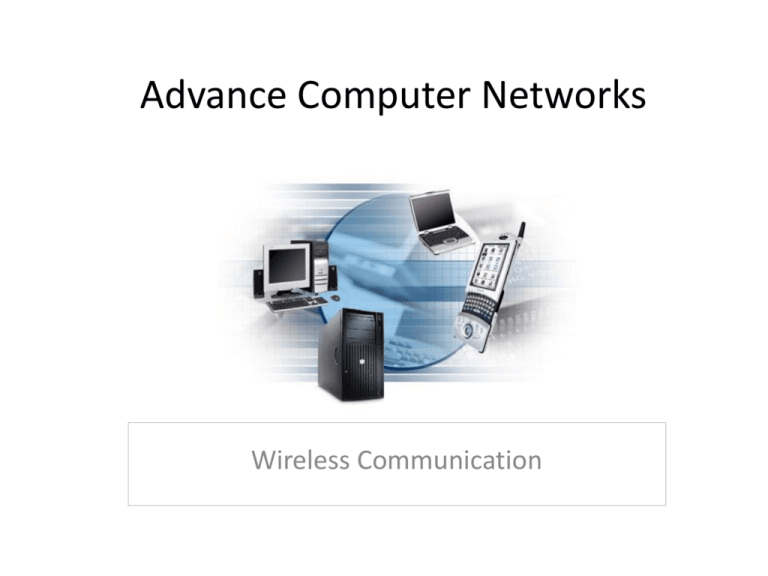
Advance Computer Networks Wireless Communication Why Wireless Communication? Question: Why do we need a new technology when we have such a developed public telephone network. Answer: Mobility. Confinement Versus Freedom 2 Challenges of Mobility Challenges of using a radio channel: The use of radio channels necessitates methods of sharing them – channel access. (FDMA, TDMA, CDMA) The wireless channel – poses a more challenging problem than with wires. Bandwidth: it is possible to add wires but not bandwidth. So it is important to develop technologies that provide for spectrum reuse. Privacy and security - a more difficult issue than with wired phone. Others: low energy (battery), hand off, roaming, etc. 3 First Generation Systems Cellular concept emerges in early 1970s. Cellular technology allows frequencyreuse. With this we need to have Handoff (handover) In 1G we had analog voice but Control Link was digital 4 Examples of First Generation Cellular Systems (FDMA based) 1) Advanced Mobile Phone System (AMPS) 2) Narrowband AMPS (NAMPS) 3) Nordic Mobile Telephone (NAMPS) 4) European Total Access System (ETACS) 5) Japanese TACS (JTACS) 6) Nippon Telephone and Telegram (NTT) 7) Cordless Telephone 2 (CT2) 5 First Generation – AMPS and European Total Access Cellular System (ETACS) Parameter AMPS ETACS Multiple Access FDMA FDMA Duplexing FDD FDD Channel Bandwidth 30kHz 25kHz Traffic Channel per RF Channel 1 1 Reverse Channel Frequency 824 – 849 MHz 890 – 915 MHz Forward Channel Frequency 869 – 894 MHz 935 – 960 MHz Voice Modulation FM FM Peak Deviation: Voice Channels Control/Wideband Data ± 12 kHz ± 8 kHz ± 10 kHz ± 6.4 kHz Channel Coding for Data Transmission BCH(40,28) on FC/BCH(48,36) on RC BCH(40,28) on FC/BCH(48,36) on RC Data Rate on Control channel 10kbps 8kbps Spectral Efficiency 0.33 bps/Hz 0.33 bps/Hz Number of Channels 832 1000 6 Digital Communication: Transmitter From Other Channels 1010010 Analog input Analog to Digital Converter Bits 10110 Source Encode 01101 Multiplex Encrypt Encoded Bits Encrypted Data 01101 Multiplexe 01010 d Data 10101 Digital Bandpass waveform Pulse modulated waveform Bandpass modulate Bit to Sym. & Pulse Modulate Channel Encoded Data Scrambled data Channel Encode 100110 1 Scrambler 10001 7 Digital Communication: Receiver Digital Bandpass waveform Digital Baseband waveform De-modulate Bits Equalizer, Timing and Sym. to Bits Channel Decode Channel Decoded Data 01101 Descramble Descrambled 10001 Bits Source Decoded Bits Analog output D/A 101001 0 Demultiplexe d Bits Decrypted Bits Source Decode Decrypt 10110 DeMultiplex To other Channels 8 Performance Metrics • Analog Communication Systems ^ m(t)m(t) – Metric is fidelity: want – SNR typically used as performance metric • Digital Communication Systems ^ are data rate (R bps) and probability of – Metrics bit error (Pb=p(bb)) – Symbols already known at the receiver – Without noise/distortion/sync. problem, we will never make bit errors 9 Second Generation Cellular Systems (TDMA and CDMA based) 1) GSM (Global System for Mobile) 2) PDC (Personal Digital Cellular) 3) PHS (Personal Handy System) 4) DAMPS (Digital AMPS) 5) CDMAone (IS-95) 6) Personal Communication System (PCS)-1900 (IS-136) 10 Second Generation – IS136/CDMA/GSM Parameter IS-136 IS-95 GSM Multiple Access TDMA/FDD CDMA/FDD TDMA/FDD Modulation π/4 DQPSK BPSK GMSK Channel Bandwidth 30 kHz 1.25 MHz 200 kHz Reverse Channel Frequency Band 824 – 849 MHz 1.85 – 1.99 GHz 824 – 849 MHz 1.85 – 1.99 GHz 890 – 915 MHz 1.85 – 1.99 GHz Forward Channel Frequency Band 869 – 894 MHz 1.85 – 1.99 GHz 869 – 894 MHz 1.85 – 1.99 GHz 935 – 960 MHz 1.85 – 1.99 GHz Channel Data Rate 48.6 kbps 1.2288 Mcps 270.83 kbps Carrier Spacing 30 kHz 1.25 MHz 200 KHz Speech Coding VSELP(Vector Sum excited linear prediction) CELP RPE-LTP Users per carrier 3 variable 8 11 Second Generation –Benefits Higher Capacity, Mobility Easy frequency planning -Dynamic Channel Allocation (GSM) -Single Frequency Band (CDMA) Better performance -Low dropped call rate -Faster switching MAHO (Soft Handoff in CDMA) Error correction -FEC -Interleaving Value-added Services -SMS -Limited data transmission capabilities 12 Second Generation - Success Four operational digital cellular technology: Dec’ 2000 Source: EMC Database 13 Evolution to 2.5G Mobile Radio Networks (data-centric) 1. High speed circuit switched data (HSCSD): GSM 2. GPRS for 2.5G GSM and IS-136 3. EDGE for 2.5G GSM and IS-136 4. IS95B and CDMA2000 1x 14 General Packet Radio Service (GPRS) 15 Enhanced Data for Global Evolution (EDGE) • EDGE uses 8PSK as opposed to GMSK as a modulation scheme. Essentially squeezing in more data in the available bandwidth. • Data rates closer to 3G. Intended to be used by operators who don’t have a 3G license but wish to deliver higher data rates. • Requires all the radio cards in the existing GSM/GPRS network to be replaced. • Expensive solution to obtain similar data rates to the lowest expected 3G performance. • Raw data rate using one GSM carrier can go up to 547.2 kbps (practical 384 kbps) 16 IS 95 B and CDMA2000 1x • • • • • The 2.5 G Evolution of IS95 A. Uses extra codes for increased data rates Data Rates upto 115.2 kbps Easy upgrade to CDMA2000 Intermediate steps to 3G: – CDMA2000 1x, Release 0: Data rates of up to 153.6kbps – CDMA2000 1x, Release A: Data rates of up to 307.2 kbps 17 IMT-2000 (3G) • The International Telecommunications Union (ITU) defined the key requirements for International Mobile Telecommunications 2000 (IMT-2000) services. • These requirements were that the system should support data rates of: • 2 Mbps in fixed or in-building environments • 384 kbps in pedestrian or urban environments •144 kbps in wide area mobile environments • IMT-2000 is more commonly known as… 3G. 18 Migration Path 2000 Japa n PDC Europe GSM 2001 2002 2003 W-CDMA GPRS EDGE HSCSD Americ a AMPS/D-AMPS IS-95A 2G System 3G System D-AMPS IS-95B CDMA2000 Easy upgrade Upgrade requiring new modulation Upgrade requiring entire new radio system 19 Universal Frequency Reuse Frequency Reuse Factor = 7 for AMPS CDMA Universal Frequency Reuse CC BB C B GG A G DD AA D EE FF E C F B D A G A E F Frequency Reuse Factor = 4 for TDMA systems A A A A A A A A A A A A A A A A A A A A A 20 CDMA2000 • Evolution of 1x RTT concept • High data rate service which is compatible to IS 95 • 1x EVDO: Evolution of the 1x system data optimized • As in 1x-RTT technology utilizes 1.25 MHz of band • System requires a separate carrier for the data • 2.4 Mbps forward link, 153.3 kbps reverse link • Rev. A: Support for VoIP: 3.1 Mbps FL, 1.8 Mbps RL • New revisions: B and other enhancement 21 3G W-CDMA (UMTS) • High-Speed Downlink Packet Access (HSDPA) • HSUPA and HSPA, HSPA+ Phase 1 and 2 22 TD-SCDMA 23 Timeline: For UMTS and CDMA2000 24 5) Wireless Local Loop 25 WIRELESS LOCAL LOOP • Definition: A telephone system where subscribers are connected to the public switched telephone network using radio signals rather than copper wire for part or all of the communication between the subscriber and the switch. • Countries with available elaborate telecommunication infrastructure used it to increase competition • Countries without available elaborate telecommunication infrastructure use it for efficient and feasible method of broadband delivery 26 Some Countries using CDMA for WLL Algeria, Azerbaijan, Bermuda, Brazil, Cambodia, China, Columbia, Dem. Rep. of Congo,Dominican Republic, Egypt, Ethiopia, Fiji, Guatemala, Haiti, India, Indonesia Kenya, Kuwait, Laos, Malaysia, Mauritius, Mexico, Moldova, Nepal, Nigeria, Pakistan, Poland, Puerto Rico, Romania, Russia, Uganda, Ukraine,Vietnam,Yemen 27 6) Other Systems 28 WIRELESS LOCAL AREA NETWORKS (WLANs) • Network- group of two or more computer systems linked together. Local area networks are usually confined to one building. • Wireless Fidelity (Wi-Fi) – 802.11a (DS-SS) became standard (2Mpbs). – 802.11b is common (11Mbps) 2.4 GHz. Also has the FH-SS extension. – 802.11g also uses the 2.4 GHz band. Data Rate: 54 Mbps. Uses OFDM – 802.11n: Uses OFDM and MIMO 29 Other Standards • Long Term Evolution – Initial Deployment in the 700 MHz Frequency Band – Data Rate of tens of Mbps – Uses OFDM and MIMO • Worldwide Interoperability for Microwave Access (WiMax) – Operate in the 2.5, 3.5, or 5.8 GHz bands. – Data Rates of tens of Mbps. – Versions: IEEE 802.16d and e with amendments like: 802.16f, g, h, i, j and k – Uses OFDM and MIMO • Variants of both are candidates for IMT-Advanced (4G) 30 7) IMT-Advanced(4G) 31 IMT-Advanced (4G) • The min requirements for peak spectral efficiencies – Downlink peak spectral efficiency is 15 bit/s/Hz – Uplink peak spectral efficiency is 6.75 bit/s/Hz. • Six Proposals are under review • Some are based on WiMax 802.16m and some on LTE • Both uses OFDM and MIMO • Final Decision by October 2010 32 IMT-Advanced (4G): Time-Line WP 5D meetings 2008 No.1 (0) No.2 2009 No.3 No.4 2010 No.5 No.6 No.7 No.8 2011 No.9 No.10 Step1 and 2 (20 months) Step 3 (8 months) (1) Step 4 (16 months) Steps 5,6 and 7 (20 months) (2) (3) Steps 8 (12 months) (4) Steps in radio interface development process: Step 1: Issuance of the circular letter Step 2: Development of candidate RITs and SRITs Step 3: Submission/Reception of the RIT and SRIT proposals and acknowledgement of receipt Step 4: Evaluation of candidate RITs and SRITs by evaluation groups Step 5: Review and coordination of outside evaluation activities Step 6: Review to assess compliance with minimum requirements Step 7: Consideration of evaluation results, consensus building and decision Step 8: Development of radio interface Recommendation(s) Critical milestones in radio interface development process: (0): Issue an invitation to propose RITs (1): ITU proposed cut off for submission of candidate RIT and SRIT proposals March 2008 October 2009 (2): Cut off for evaluation report to ITU June 2010 (3): WP 5D decides framework and key October 2010 characteristics of IMT-Advanced RITs and SRITs (4): WP 5D completes development of radio February 2011 interface specification Recommendations IMT-Advanced A2-01 Cellular Technology Roadmap 34 8) Wireless Operators in Pakistan 35 Cellular Operators in Pakistan 1) Mobilink Technology: GSM, GPRS, EDGE (WiMAx deployment: Infinity) 2) Ufone Technology: GSM, GPRS, EDGE 3) China Mobile Pakistan (CMPak, Paktel): Zong Technology: EGSM, GPRS, EDGE 4) Warid Technology: GSM, GPRS, EDGE (Associated company Wateen: WiMax) 5) Telenor Technology: GSM, GPRS, EDGE 36 WLL Operators 1) V-PTCLWirless Technology: CDMA2000, EVDO Rev. A 2) TeleCard Technology: CDMA2000 3) WorldCall Technology: CDMA2000, EVDO Rev. A 4) Diallog (negotiation going on with World Call) Technology: CDMA2000 1x, EVDO 5) SCO Technology: CDMA2000 1x, EVDO (?) 37 Latest News (Pakistan) • • • • Auction of 3G spectrum???????? Only Mobile operators are eligible to bid ?? Three licenses to be issued?? Possible (UMTS FDD Band I): – 1920 to 1980 MHz (Up link) – 2110 to 2170 MHz (Down link) • WiMax has been deployed 38 Issues with widespread usage of wireless data Why are new services/mobile content required? Tough competition Low ARPU No differentiation in Service Offerings Problem: What services will differentiate one operator from the other? How would these services be delivered? 39 Technologies 2G: Mainly Voice & SMS 2.5G: Limited Data Capability 3G and Beyond: High Speed Data coupled with data centric applications and services 40 Services Evolution With Enriched User Experiences Mobile TV Voice Wallpaper 2D Gaming Location Based Services Mobile Commerce 3D Gaming Services Evolution Text Paul, Messaging How did the meeti ng go? Send Option s Ringtones MMS Music & Video on Demand Blogging Social Networking RSS Feeds & Tagging 41
